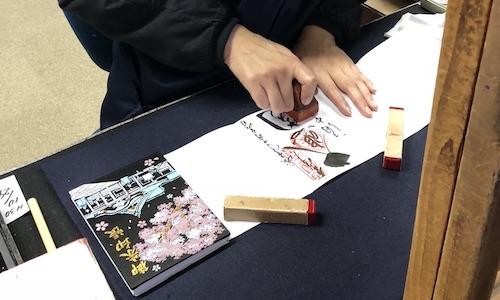The most amazing memory we brought home with us from Japan is our goshuincho, the Honorable Red Stamps Book. It’s a very unique souvenir: it is the result of our interest in Japanese temples and shrines, it shows our patience in worshipping (and queuing), and it will remind us of every temple we visited and admired.
If you also value meaningful and special souvenirs more than fridge magnets, keep reading and get ready to collect your stamps!
Help me run my blog! This post contains some affiliate links: the small commission I may earn if you click through and make a purchase/booking (at no extra cost to you) will go towards supporting the site and our travels. That means more posts and useful info for you!
We only recommend products we use ourselves and believe in. Thank you for supporting Travelling Sunglasses!
Click here to read our full disclosure.
What is a goshuincho?
A goshuincho is an accordion-fold notebook made to collect the goshuin, the unique, handmade stamp that each Buddhist Temple and Shinto Shrine writes. It is also written goshuin-cho. In Japanese, it means Honorable (go) red stamps/seals (shuin) book (cho)
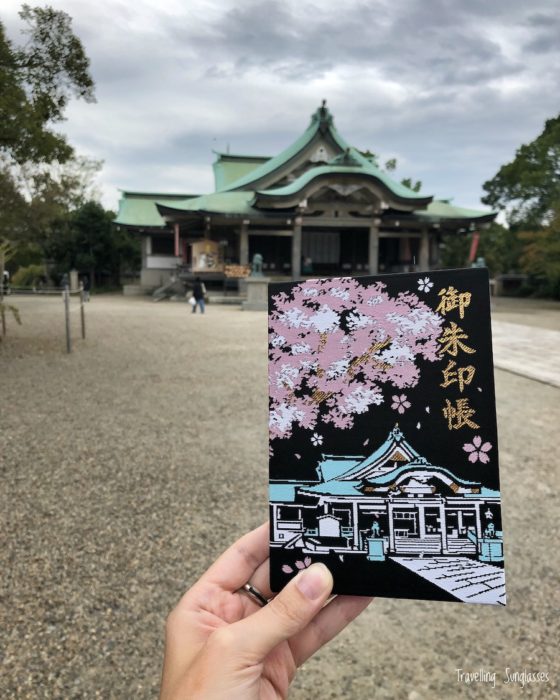
Starting centuries ago, Japanese people would collect shrines seals as certification of their worship. Slowly, the goshuincho book became the way to collect shrine stamps and seals, as proof of pilgrimage. Many even keep two separate books, one for Buddhist Temples and one for Shinto Shrines. A complete goshuincho, it is said, gives spiritual fulfillment; some very devoted believers even want to be buried with their book.
Nowadays, and even more for foreigners or non-believers, it’s more about one’s journey to Japan, and what memories they associate with Japanese places of worship.
Aesthetically speaking, there are many types of covers: they come in plain colours, with a design or drawing, and in many materials. It opens up like an accordion, so be careful not to drop it! And, of course, it opens to the left, opposite compared to the way us westerners would open it.
You can find lots of examples here on Gosyunibito.com, a site devoted to goshuincho and shrines.
Where can I buy a goshuincho?
Before you start collecting stamps, you must buy your notebook.
You can buy a goshuincho at most temples or shrines for 1000-2000 YEN (appprox. 8-16 EUR). There is an office or reception desk, usually close to the entrance of the temple grounds, where you can buy also amulets and other worshipping items. Keep in mind that most shrines and temples close at 4.30 or 5 in the afternoon.
I bought ours at Hokoku Shrine, within Osaka Castle.
As they become more and more popular, they are sold also at stationary shops.
How do I use a goshuincho?
First of all, you should pay your respects and pray at the shrine or temple you are visiting (more details here). Respect the crowd and make a donation in the box.
Afterwards, find the specific office or wooden hut where the goshuin stamp is made by the local monks, somewhere on the shrine/temple grounds. Usually, it’s the one with the longest queue 🙂 .
The price for the stamp is usually around 300 YEN (only at Senso-ji in Tokyo we paid 500 YEN).
Open the booklet to a new, white page and hand it over to the monk with both hands. If multiple stamps and calligraphies are available, make your choice beforehand and don’t waste their time. Make sure you have the exact change to pay them. Remember to thank them with “Arigato gozaimashita!”
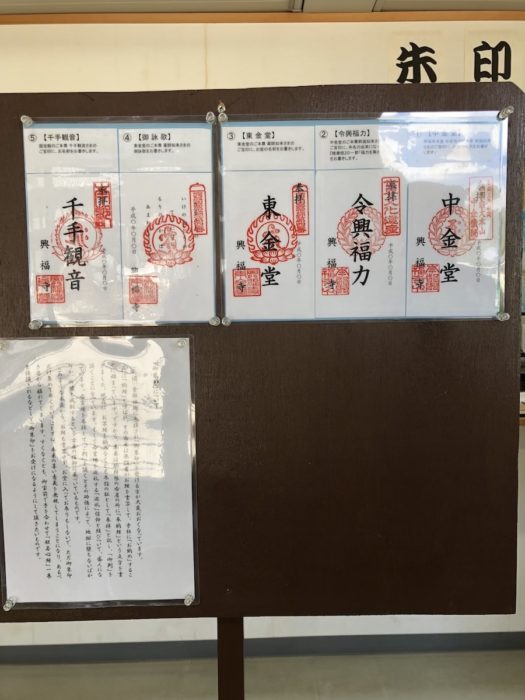
Even though each page should have a stamp, I decided to leave an empty page next to each stamp I got, in order to write there the place and date and a few personal impressions (I failed to write the impressions… someday, I will!).
Apart from the specific red stamp of the temple/shrine, the black calligraphy tells the place and date, the name of the shrine, and possibly other words like “worship”.
Some offices, especially if it’s a crowded day, may take your booklet, give you a number, and tell you to come back in a while.
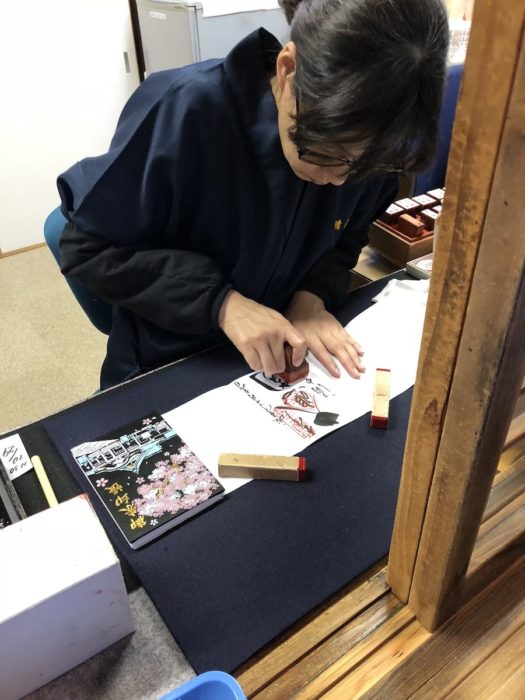
The best souvenir from Japan
When researching for our first trip to Japan, I stumbled upon pictures of beautiful Japanese calligraphy, all collected nice and tidy in a booklet. I’m so happy I learnt about the goshuincho booklet before going to Japan! It was the first thing I looked for at the first shrine we visited – and we planned to visit a lot of them.
Among all the cute memories, objects and postcards we brought back, the goshuincho is the best, the most authentic and meaningful souvenir for us: a true memento of our journey, and a collection of beautiful Japanese art.
For us, the most fascinating moments are always when the priest/monk/volunteer takes the bamboo brush, dips it in ink, and gracefully traces the lines of the calligraphy. Sometimes, different calligraphies are available, which provides for an even deeper feeling of uniqueness. I would wonder how many times every day these people draw the same calligraphy on hundreds of booklets, how many people gaze at them in wonder, trying to impress in their memory the zen calm of each movement. It is a truly wondrous show of Japanese dedication to their culture.
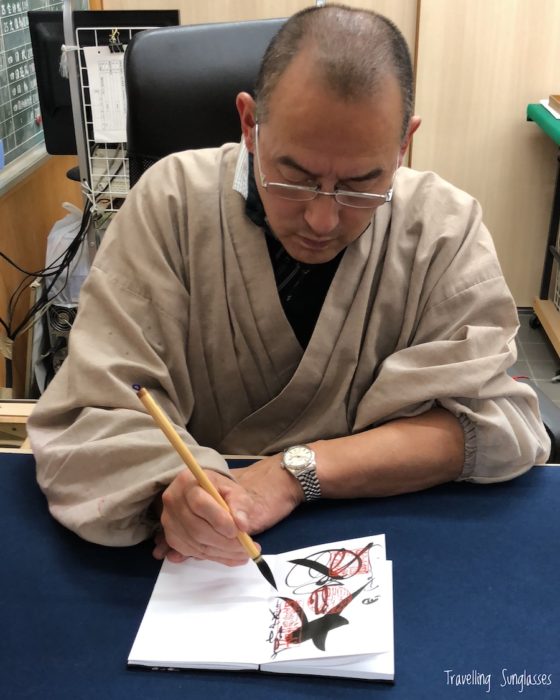
These services and apps made my trip to Japan much easier and enjoyable! Check them out:
- The Wise Multicurrency Card where I could exchange money into yen with 3 taps on my phone, and save on unexpected bank fees
- Booking.com and its clear layout made it easy to choose and manage our accommodations
- Google Maps, full of attractions saved and very useful for the local public transport
- OneNote where I had all my plans and notes of where to go and what to do
- Snapseed for easy and quick photo editing
- And most of all, Japan Wireless, because we always needed an internet connection to make it all work! We used the handy Pocket Wifi, and next time we’ll try the magical eSIM.
Be efficient! More tips, dos and don’ts
- First pray, then collect the stamp. It is considered rude to do it the other way round.
- If you’re on a budget, consider how 300-500 YEN per stamp (plus the donation in the box) will affect your expenses.
- Be respectful: do not use the goshuincho for other stamps or writing (unfortunately, I failed at this).
- Do not take pictures or videos if it is not allowed.
- Wait patiently in line, without eating or drinking.
- The priest will insert a piece of blotting paper, so that the fresh stamp won’t stain the other page.
- The goshuincho belongs to you. It is not a gift meant for others.
- Take a picture of the new stamp in front of the temple or shrine, to remember where you got it 🙂
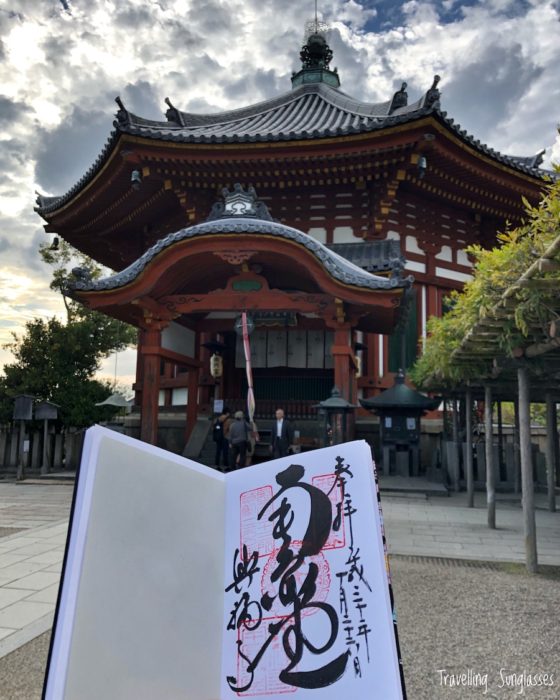
Be spontaneous! What if…
- What if I haven’t purchased a goshuincho yet? Some shrines/temples also provide their stamp on a separate sheet of paper. Do not ask for the stamp on a random notebook or piece of paper.
- What if I don’t have cash? I don’t remember if they would accept cards, but I don’t think so.
- What if I used the goshuincho for other stamps, like the ones at metro stops? Well, that’s a bit disrespectful to a religious item, so be prepared to apologize if a priest lectures you!
Plan your perfect trip to Japan with my detailed and inspiring posts:
- 2-week honeymoon itinerary in Japan, our full guide with maps and details
- How much we spent on our honeymoon to Japan
- Useful and practical travel tips to plan your trip to Japan
- 5 unique Japanese experiences you have to try
- The most unique Japanese souvenir: the Goshuincho book
Is a goshuincho a good souvenir for me?
If you plan to visit many shrines and temples, if you like hand-made souvenirs, if you like authentic and personal mementos, if your budget is not super-strict: yes! The goshuincho is the perfect Japanese souvenir for you. And most probably you will still have some empty pages left, for your next trip!
Are you planning to go to Japan? Check out our super-efficient 2-weeks itinerary and be inspired by our favourite unique Japanese experiences.
Do you already have a goshuincho? Let us know in the comments!
Cheers!

